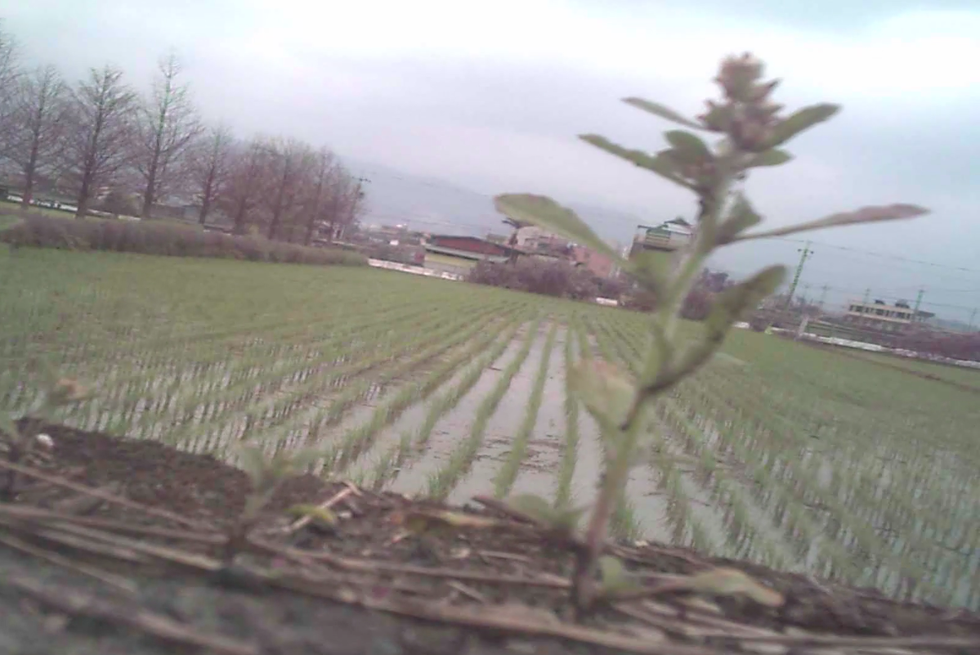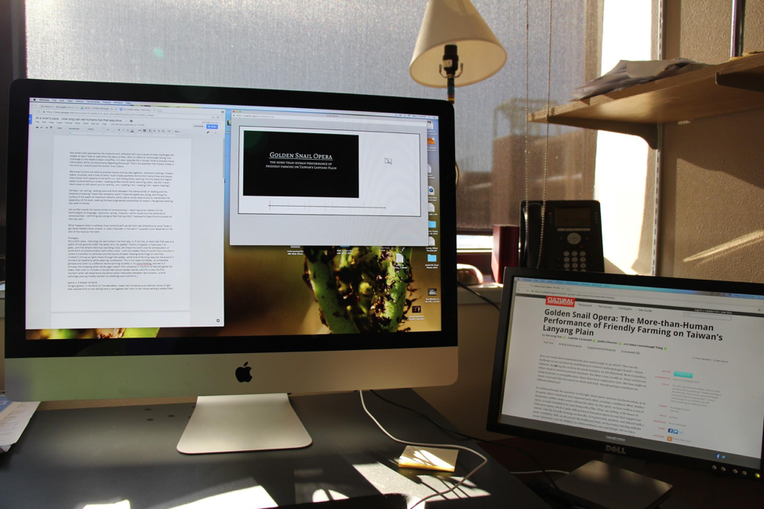
At a snail’s pace . . . how long can we humans live that way—or if not live, at least look at a patch of silty ground under the water of a rice paddy? There’s a majesty in how slow it all goes. The almost electric-sounding clicks, are these the snail’s means of echolocation or some form of communication with other snails? The sudden flow of current after four minutes ushers in a transition to darkness and the sound of running water, while frogs (or are they crickets?) chirrup and lights move through the paddy. What kind of farming requires handwork in the dark, with little more than a headlamp and muck boots? (The short answer, we learn, is “friendly farming.”) These are not Iowa cornfields, but an embodied glimpse and auditory snippet of a different lifeworld unfolding. We’re more than five minutes into the experience when words assert their presence in the form of text alongside the video. Not until nearly eleven minutes in do we hear actual speech, and this is also the first moment when we see any direct social interaction between two humans: a brief exchange while passing muddy-rooted seedlings back and forth.
Any writer who approaches his or her material with reflective skill and a sense of style challenges the reader to learn anew how to read what has been written. I have often thought that anthropologists should practice better formal reflexivity, or reflexivity of form, when writing about the varieties of human experience we study. Every cultural context requires the ethnographer to attune to the most accurate and evocative ways to share the insights discovered. The best ethnographic monographs, to my mind, have always been ones that create their own formal structures to contain and unpack what has been learned on the journey. No two ethnographies should take the same form.
With an effort at multimodal telling, this challenge of teaching the reader/viewer how to make sense of the work amplifies.
Is it even possible for a human mind to process visual information while simultaneously digesting discourse? That’s the question that hovers slowly in my mind as I watch/read/hear “Golden Snail Opera: The More-than-Human Performance of Friendly Farming on Taiwan’s Lanyang Plain,” a collaborative, multimodal article by Yen-Ling Tsai, Isabelle Carbonell, Joelle Chevrier, and Anna Lowenhaupt Tsing.
We know humans are capable of processing visuals and sounds together; shamanic healings, theater, opera, musicals, and a host of other multimodal aesthetic forms from many times and places have shown us that capacity. But sitting alone, peering into the pixels of a digital space constrained by a screen, reading written words while watching video and also processing audio: we don’t even have a way to talk about such an activity. Am I reading? Am I viewing? Am I listening? Am I reading-watching-listening?
Perhaps I am sailing, tacking back and forth between the lateral winds of reading and hearing and the tailwind of viewing. A tailwind speeds you along, skimming the surface of the water at maximum velocity, while lateral winds require you to manipulate the boat, tacking for the best possibilities to move toward the destination you seek.
Are written words the lateral winds of consciousness, requiring some mastery of the technologies of language and analysis—grammar, syntax, linearity, logic? Are visuals the tailwinds of consciousness, skimming you along so fast that you may not have time to mentally process all that you see?
What happens when a sailboat must contend with winds from two directions at once? Does it get faster, better, more nimble, or does it founder in the swirl? Much depends on the skill of the hand at the helm and the crew on deck.
Reading or watching or listening, or whatever it is I am doing while engaging with the “Golden Snail Opera” is a fascinating and challenging practice. Old habits of reading (underlining, making comments in the margins, and so on) fail to help me navigate. While watching the video, I find myself wishing for a video annotation tool (something like VideoANT, which I use in my classes to comment on student-produced videos). How, I find myself wondering, can I develop insights of understanding through engaging with the piece and hold on to them so that they can be useful in my future thinking and work?
Ultimately, I had to create a proper setting to be able to move between the analytical and the experiential. Here’s what my engagement environment looked like.

The authors have provided their take on how one should engage with the piece, indicating when you should stop reading and only watch by using a crossed-out book icon, and then providing text that scrolls alongside the video when they want you to engage with the words of their three characters: the Farmer, the Pedant and the Wanderer. However, I admit that I had to cheat by tacking between the different modes of attention needed. I frequently stopped the video to give myself more time to read the text. Or I read the text while the video played, and then had to go back to rewatch the footage that I had missed while concentrating on reading. In the end, I even went further and copied the entire text from the reading window and pasted it into my notes for later reference. Logocentric habits die hard.
This piece took a different kind of mental energy than reading a conventional scholarly article. I found myself having to take it up in segments, spending at most an hour at a time working through a couple of sections and then leaving it for a couple of hours (or overnight) before returning. I am grateful for the scenic structure that the authors provided, breaking up the roughly hour-long video into seven scenes that suggest a dramatic arc to follow.
In the end, I think I’ve emerged with some new kind of sensory and intellectual understanding of the experiences of rice farmers and researchers on the Lanyang Plain of Taiwan. I know I felt a slight chill along my spine, registering the experience of the hungry ghosts of the place. I might even have a small sense of what life looks and sounds like for a dog or a snail among the rice paddies (though the recalcitrant ducks refused to aid in this human-led endeavor.)
I’m not sure how often I can reserve three full days to read and think about a single article, but if such an article is done in the rich manner of the “Golden Snail Opera,” I think it will be worth the effort. As coeditor of Anthropology and Humanism, I will look to Cultural Anthropology's Sound + Vision initiative for further experiments into the future of the anthropological research article. Thanks to the editorial team for charting a course!